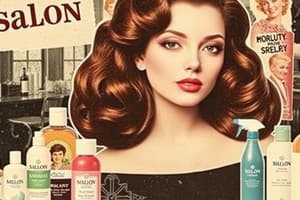Podcast
Questions and Answers
What is the key difference between disinfection and sterilization in the salon industry?
What is the key difference between disinfection and sterilization in the salon industry?
- Disinfection and sterilization are the same process, just different names used interchangeably.
- Disinfection is a more thorough cleaning process compared to sterilization in the salon industry.
- Disinfection kills most germs, while sterilization removes all forms of bacteria, fungi, and viruses, including their spores. (correct)
- Sterilization kills most germs, while disinfection removes all forms of bacteria, fungi, and viruses, including their spores.
Which of the following is the MOST important step in maintaining a hygienic salon environment?
Which of the following is the MOST important step in maintaining a hygienic salon environment?
- Regularly sanitizing surfaces with disinfectants after each client's use. (correct)
- Ensuring no water comes into contact with the pivot points of razors and shears.
- Properly drying and storing cleaned implements in a clean location.
- Thoroughly washing metallic implements with warm soapy water to avoid corrosion.
Which of the following disinfection methods is LEAST effective at killing target organisms in the salon industry?
Which of the following disinfection methods is LEAST effective at killing target organisms in the salon industry?
- Fumigation
- Use of disinfectants like quats or phenol compounds
- Use of antiseptics like alcohol (correct)
- Liquid disinfectant
Why is it important to avoid getting water near the pivot points of razors and shears during cleaning?
Why is it important to avoid getting water near the pivot points of razors and shears during cleaning?
Which of the following is the LEAST important step in the process of cleaning metallic implements in the salon industry?
Which of the following is the LEAST important step in the process of cleaning metallic implements in the salon industry?
Which of the following statements about hygiene practices in the salon industry is not true?
Which of the following statements about hygiene practices in the salon industry is not true?
Which of the following methods is not mentioned in the text as a technique for sterilizing salon tools?
Which of the following methods is not mentioned in the text as a technique for sterilizing salon tools?
What is the primary difference between sterilization and disinfection in the context of the salon industry?
What is the primary difference between sterilization and disinfection in the context of the salon industry?
In which of the following situations is full sterilization of salon tools essential, according to the text?
In which of the following situations is full sterilization of salon tools essential, according to the text?
Which of the following statements about cleaning tools and workstations in the salon industry is correct?
Which of the following statements about cleaning tools and workstations in the salon industry is correct?
Flashcards are hidden until you start studying
Study Notes
Maintaining Hygiene and Ensuring Safety: Sanitation in the Salon Industry
The salon industry revolves around personal grooming and beauty treatments, but it also requires strict attention to hygiene and sanitation practices. Proper maintenance of tools, equipment, and workspaces is critical for maintaining clients' health and safety. In this article, we delve deeper into hygiene practices, sterilization techniques, disinfection protocols, and cleaning tools and workstations prevalent in the salon business to ensure optimal service quality and health protection.
Hygiene Practices
Maintaining good hygiene is an essential part of the salon industry. Regularly cleaning and sweeping the salon floor helps remove debris and residue that could harbor bacteria and viruses. Employees must also practice frequent hand washing with warm water and soap, avoiding touching their eyes, nose, and mouth to minimize the likelihood of spreading germs.
Sterilization Techniques
Sterilization is the process of killing all germs, including bacteria, fungi, and viruses. In most cases, full sterilization isn't necessary for salon tools since they usually don't penetrate the skin's barrier. However, for certain situations, like when tools come into contact with cuts, wounds, or blood, full sterilization is essential. Sterilization can be achieved through boiling, steaming, baking, irradiation, or using chemical agents.
Disinfection Protocols
Disinfection aims to eliminate harmful bacteria and viruses. Open wounds pose a higher risk of infection, so disinfecting tools and surfaces after use is crucial. Disinfectants should be chosen based on their ability to kill target organisms effectively and efficiently. Common disinfection methods include liquid disinfectant, fumigation, and the use of antiseptics and disinfectants such as alcohol, quats, or phenol compounds like Barbicide.
Cleaning Tools and Workstations
Cleaning tools and workstations regularly is key to maintaining a hygienic salon environment. Procedures for cleaning instruments involve thorough washing with warm soapy water, followed by proper drying and storage in a clean location. For metallic implements, it's important to avoid getting water near the pivot points of razors and shears, as these areas tend to corrode when exposed to moisture. Regular cleaning of workstations involves sanitizing surfaces with disinfectants after each client's use, ensuring that the next customer will have a clean and safe area for their treatment.
Conclusion
In conclusion, maintaining proper hygiene practices is essential in the salon industry. Sanitization means washing tools regularly with warm water and soap to remove visible dirt and product buildup, while sterilization removes all forms of bacteria, fungi, and viruses, including their spores. Disinfection kills most germs present on salon tools and surfaces, but not all spores and viruses are destroyed by this process. Proper cleaning of equipment and workstations involves using warm soapy water for metallic implements, ensuring no water comes into contact with shears and razors' pivot points, and sanitizing surfaces after each client's use. By implementing these practices, salons can ensure that their clients receive safe and hygienic treatments every time they visit.
Studying That Suits You
Use AI to generate personalized quizzes and flashcards to suit your learning preferences.




